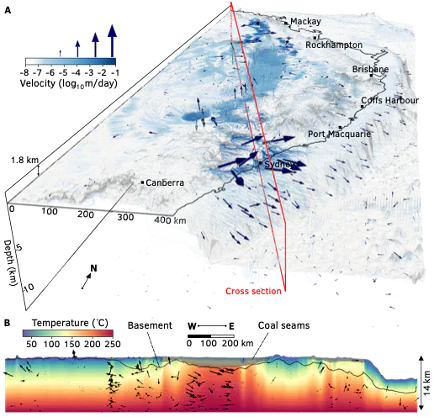Continent-scale groundwater models: constraining flow pathways across eastern Australia

Abstract
Numerical models of groundwater flow play a critical role for water management scenarios under climate extremes. Large‑scale models play a key role in determining long range flow pathways from continental interiors to the oceans, yet struggle to simulate the local flow patterns offered by small‑scale models. We have developed a highly scalable numerical framework to model continental groundwater flow which capture the intricate flow pathways between deep aquifers and the near surface. The coupled thermal‑hydraulic basin structure is inferred from hydraulic head measurements, recharge estimates from geochemical proxies, and borehole temperature data using a Bayesian framework. We use it to model the deep groundwater flow beneath the Sydney–Gunnedah–Bowen Basin, part of Australia’s largest aquifer system. Coastal aquifers have flow rates of up to 0.3 m/day, and a corresponding groundwater residence time of just 2,000 years. In contrast, our model predicts slow flow rates of 0.005 m/day for inland aquifers, resulting in a groundwater residence time of ∼ 400,000 years. Perturbing the model to account for a drop in borehole water levels since 2000, we find that lengthened inland flow pathways depart significantly from pre‑2000 streamlines as groundwater is drawn further from recharge zones in a drying climate. Our results illustrate that progressively increasing water extraction from inland aquifers may permanently alter long‑range flow pathways. Our open‑source modelling approach can be extended to any basin and may help inform policies on the sustainable management of groundwater.